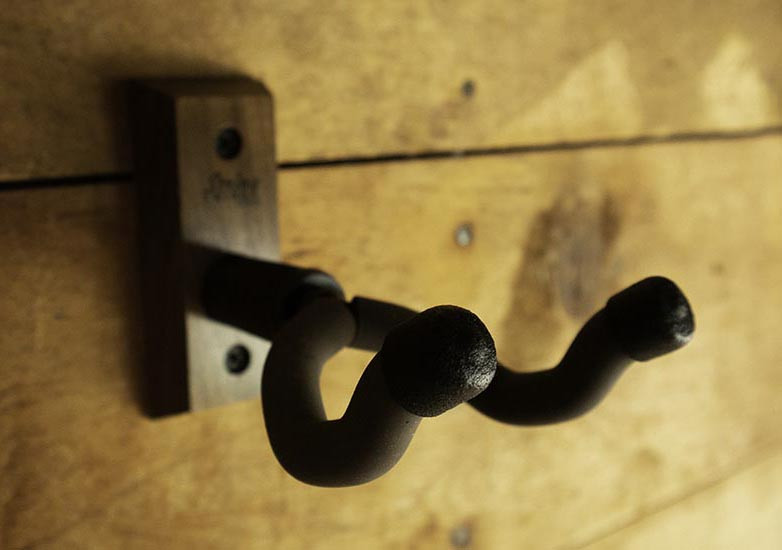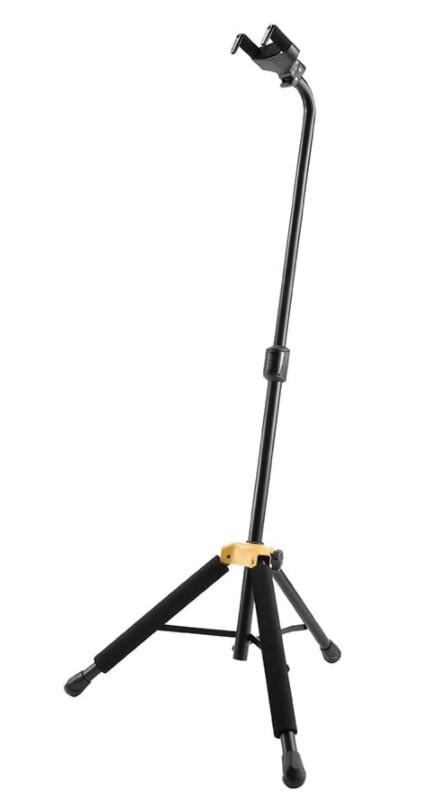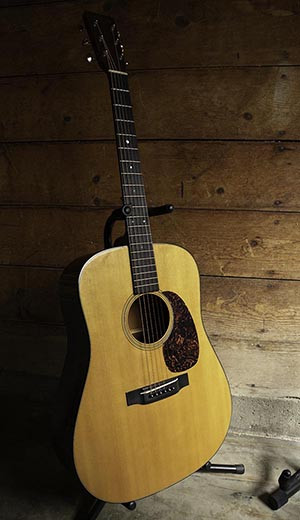Deciding how to store your guitar is crucial for its safety and your playing habits. Two popular options are guitar wall hangers and guitar floor stands, each offering distinct advantages. Guitar wall hangers excel in showcasing your instrument, protecting it from accidental knocks, and conserving space. Guitar floor stands, conversely, are often more affordable, suit specific spatial arrangements, and eliminate the need for wall drilling. This article delves into a detailed comparison of guitar stands and wall hangers, equipping you with the knowledge to make an informed decision on the ideal storage solution for your cherished guitars.
I have personal experience using various types of guitar stands and wall hangers discussed here, understanding their practical benefits and drawbacks firsthand.
Headstock Support vs. Body Support: What’s Best for Your Guitar?
A fundamental question when choosing a guitar stand or wall hanger is whether supporting the guitar by its body or headstock is preferable. Wall hangers, and certain floor stands like Hercules models, have minimal contact points with the guitar. Less contact area means the guitar’s weight is concentrated on smaller sections, potentially increasing pressure on those specific points.
While floor stands offer a broader support area, concerns about headstock damage from wall hangers are largely unfounded for healthy guitars. I’ve never encountered or heard of guitars being harmed from being hung by their headstocks. However, if you own a particularly delicate, vintage guitar, or one with a repaired headstock of questionable integrity, a high-quality floor stand might be a safer choice.
Nevertheless, neither type of guitar stand inherently poses a risk to a well-maintained guitar. Both guitar stands and wall hangers are viable options.
Aesthetics: Displaying Your Guitar
The visual appeal of a guitar displayed on a wall hook is undeniable. It elevates the instrument, presenting it prominently and transforming it into a piece of art. However, wall mounts might not always suit every room’s decor, and a guitar on the wall can sometimes feel out of place in certain settings.
 Acoustic guitar hanging on a wall hanger in a room
Acoustic guitar hanging on a wall hanger in a room
In a living room, a guitar wall hanger might be visually overwhelming. Conversely, in a dedicated music room or studio, a guitar mounted on the wall can enhance the atmosphere significantly.
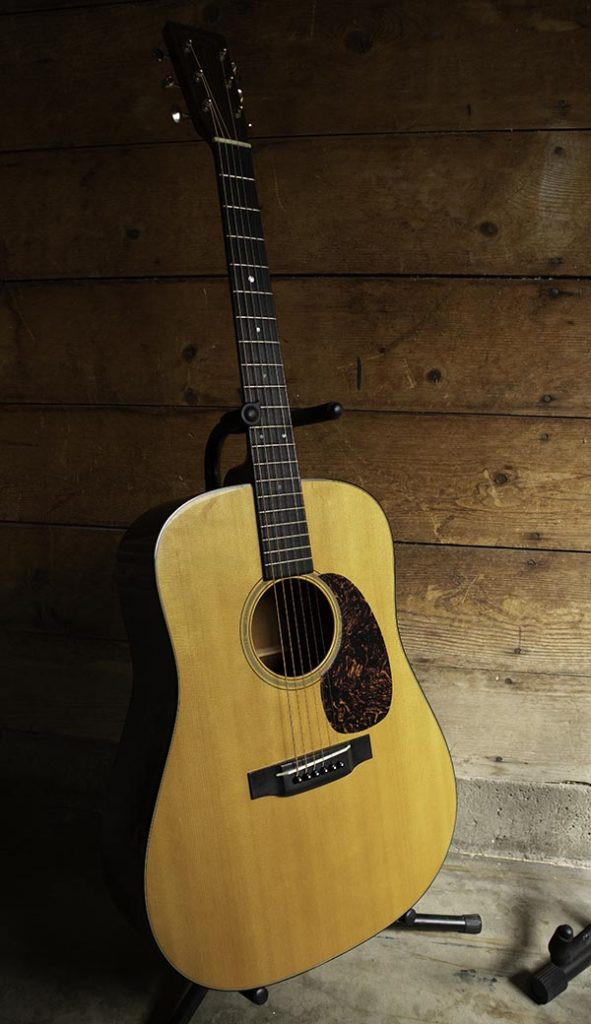 Acoustic guitar on a floor stand in a room
Acoustic guitar on a floor stand in a room
This is a subjective category, heavily dependent on the room’s style. Yet, for showcasing a guitar as a visual element, wall hangers often have a slight edge.
In terms of visual appeal, a guitar often looks more striking when displayed on a wall mount.
Protection from Damage: Safety First
A significant advantage of a guitar wall mount is its ability to keep the guitar off the floor, away from potential hazards like children, pets, and accidental bumps. If you’re concerned about accidental damage, a wall hanger provides peace of mind, as it’s far less likely to be knocked over compared to a floor stand.
Top Wall Hanger for Guitars
String Swing Wall Hanger: The Best Guitar Wall Hanger
String Swing hangers are renowned for their quality and reliability. This model securely holds both acoustic and electric guitars.
Floor stands vary in stability. Basic tubular stands with small bases offer minimal protection against tipping. While I use these simple guitar stands frequently, their stability is limited.
A-frame guitar stands offer improved stability with a wider four-legged base. While they can be unstable on uneven surfaces, their broader base provides better protection than tubular stands. However, A-frame stands are better suited for acoustic guitars; electric guitars, with their thinner bodies, can sit awkwardly and lean back too far in these stands.
Top A-Frame Guitar Stand
AmazonBasics A-Frame Stand: Great for Acoustic Guitars
This affordable guitar stand is ideal for acoustic guitars. Electric guitars may not fit as securely.
For ultimate stability in a floor stand, Hercules-style stands are the best option. These guitar stands support the guitar by the neck and body, providing exceptional security. Although pricier, the enhanced protection they offer is a worthwhile investment for safeguarding your guitar.
Premium Guitar Floor Stand
Hercules Guitar Stand: Highest Quality Floor Stand
The Hercules guitar stand is exceptional for both electric and acoustic guitars, offering superior protection compared to other floor stands.
Guitar wall hangers minimize the guitar’s exposed surface area, reducing the risk of damage from accidental impacts. Floor stands, particularly in studios, can also pose a tripping hazard with cables getting tangled in their legs, potentially pulling the stand and guitar over. Wall hangers eliminate this risk by lifting the guitar off the ground.
The design of a guitar wall hanger inherently protects the back of the guitar and minimizes the instrument’s vulnerability to damage. If protection from household hazards is a primary concern, a guitar hanger is the superior choice.
Standard Tubular Guitar Stand
Classic Tube Stand: A Standard Guitar Stand for All Guitars
This classic guitar stand is suitable for both acoustic and electric guitars but offers the least protection against accidental tipping.
In terms of damage prevention, wall hangers are the clear winner. They elevate the guitar, keeping it closer to the wall and minimizing the space it occupies, thus reducing the chances of accidental damage.
Stand Rash: Protecting Your Guitar’s Finish
As discussed in “Should I Leave my Guitar on A Stand?,” prolonged contact with guitar stands can potentially harm the instrument’s finish. This concern, known as “stand rash,” arises from the materials used in guitar stands reacting with the guitar’s finish.
Guitar stand contact points should be made of soft, inert foam that won’t degrade or discolor the guitar’s finish over time.
Extra caution is needed with guitars featuring delicate finishes, such as those found on vintage instruments with hand-rubbed or thin nitrocellulose finishes.
Ensure your guitar stand, whether floor stand or wall mount, avoids plastic or rubber components at contact points. These materials can deteriorate and react with the finish, causing discoloration. This applies to both the supports of floor stands and the headstock cradles of wall mounts.
Modern guitar stands generally use safe foam materials, minimizing the risk of stand rash. However, it’s always prudent to inspect your guitar stand for potentially harmful materials and monitor for any finish damage.
Neither floor stands nor wall mounts should inherently damage your guitar’s finish if made of appropriate materials. However, wall hangers have a slight advantage due to their smaller contact area with the guitar.
Convenience: Accessibility and Playability
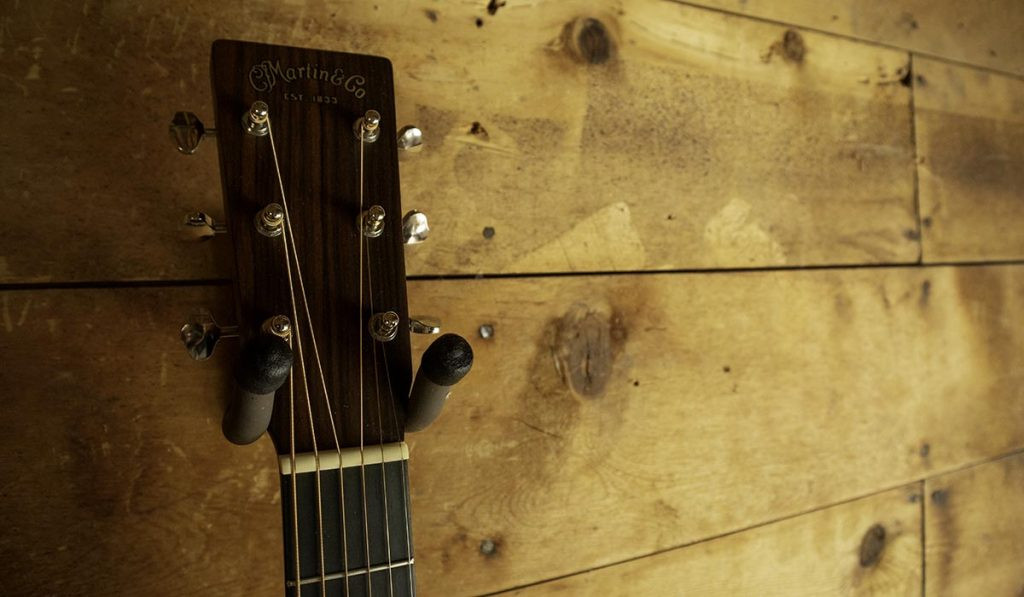 Guitar on a wall hanger in an easily accessible location
Guitar on a wall hanger in an easily accessible location
Beyond safety, convenience is paramount. The best guitar stand is the one that encourages you to play more often. Which option, a guitar stand or wall hanger, makes your guitar more accessible and inviting?
While some musicians might be diligent about playing regardless of storage method, ease of access significantly impacts playing frequency for many. Setting up a dedicated guitar space that facilitates quick access is key to playing more regularly. This is why keeping your guitar on a stand, when feasible, is generally recommended (consider humidity for acoustic guitars, as discussed later).
Wall hangers, while space-saving, can sometimes hinder accessibility. If a wall-mounted guitar is placed in an inconvenient location, obstructed by furniture or requiring extra effort to reach, you might be less inclined to pick it up daily.
When installing a guitar wall hanger, prioritize incredibly easy access. Minimize any obstacles that might deter you from grabbing your guitar and playing. Accessibility is key to consistent practice and enjoyment.
Floor stands typically win in terms of convenience. Picking up a guitar from a floor stand next to your chair is usually simpler than retrieving one from a wall hanger, especially if the wall mount isn’t optimally placed.
For ease of access and encouraging frequent playing, floor stands generally offer greater convenience.
Humidity Considerations for Your Guitar Stand Choice
The type of guitar you own influences humidity concerns when choosing between a guitar stand or wall hanger.
Do you play an electric guitar? [LINK: Do you need to humidify electric guitars?]
Or an acoustic guitar? [LINK: All you need to know about humidity]
Electric guitars are less susceptible to humidity fluctuations. Maintaining a room humidity level of 45%–55% is generally sufficient to prevent issues.
Acoustic guitars, however, are highly sensitive to humidity. If maintaining consistent room humidity is challenging, store your acoustic guitar in its case with a case humidifier. Alternatively, if you prefer to keep it on a guitar stand, use a soundhole humidifier like a Dampit.
Soundhole humidifiers release moisture inside the guitar body, preventing dryness and potential damage. Neglecting humidity control for acoustic guitars can lead to serious issues like cracks and warping.
Both wall hangers and floor stands expose guitars to the same humidity conditions. Therefore, neither option has an advantage regarding humidity control. The crucial factor is to humidify your acoustic guitar properly, regardless of whether you use a guitar stand or wall hanger, to prevent humidity-related damage.
Installation: Wall Hanger vs. Guitar Stand
Floor stands require no installation. They are ready to use right out of the box. Simply place them on a level surface, away from potential hazards, and they are ready to hold your guitar.
Wall hangers, on the other hand, require wall mounting. While some String Swing models include drywall anchors, mounting directly into a wall stud is highly recommended for maximum security. Attaching a valuable guitar to a stud provides far greater assurance than relying on drywall anchors of uncertain integrity.
According to naturalhandyman.com, drywall anchors can fail under loads as light as 10 pounds. Considering that some guitars, particularly Les Pauls, can weigh 10-12 pounds or more, drywall anchors alone present a significant risk.
Never mount a guitar wall hanger without securing it to a stud. For multiple guitars, consider mounting a horizontal board to studs and then attaching the hangers to the board, allowing for flexible spacing.
If you’re unsure how to locate wall studs, numerous tutorials are available online (e.g., “how to find a stud”).
Installation is a potential drawback of guitar wall hangers. Pre-drilling pilot holes before inserting screws into studs is advisable to ease installation and prevent wood splitting.
Floor stands are the clear winner in terms of installation, offering immediate setup without any mounting requirements or installation risks.
Conclusion: Guitar Stand or Wall Hanger – Which is Right for You?
Guitar wall hangers offer a professional and visually appealing way to display guitars. However, proper installation into a wall stud is critical to ensure the safety of your instrument.
If you find standard floor stands too unstable, consider upgrading to a Hercules guitar stand. These stands provide a wide, stable base and a secure neck clamp, significantly reducing the risk of accidental knock-overs.
Personally, I use a combination of both. I have one guitar on a wall hook for display and space-saving, while the rest are on floor stands for easy access and flexibility. As my studio evolves, I plan to incorporate more wall hooks for my guitars. Ultimately, the best “Stand For Guitar” depends on your individual needs, space, and priorities for display, safety, convenience, and guitar type.

